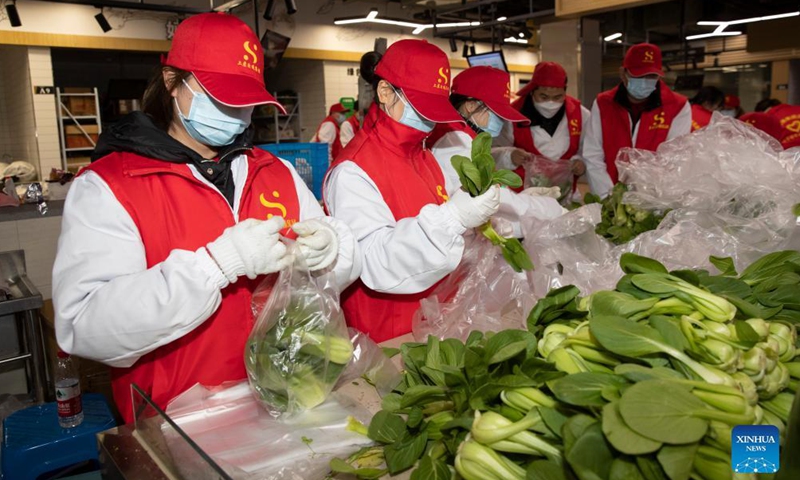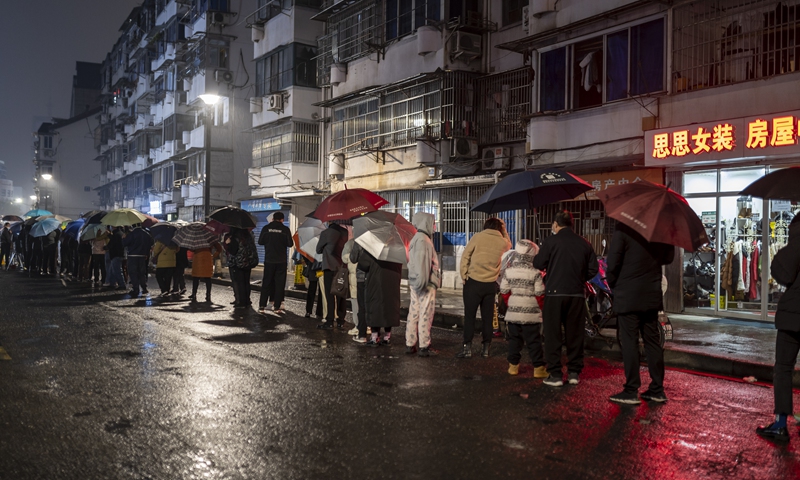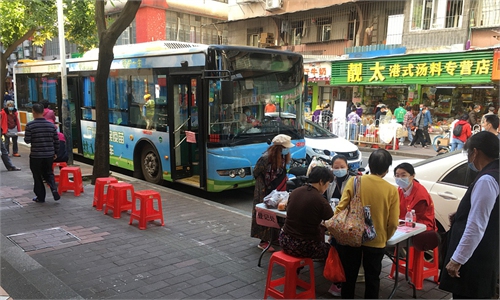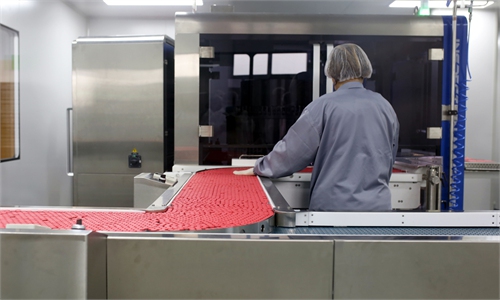Mainland reports 2 Omicron cases as supply chain threatened
Christmas orders hardly affected by sporadic outbreaks in 'world’s factory'

Volunteers pack daily necessities for distribution to residents in Shangyu District of Shaoxing City, east China's Zhejiang Province, Dec. 12, 2021.Photo:Xinhua
Less than 24 hours after North China's Tianjin reported the Chinese mainland's first case of an imported infection of the Omicron coronavirus variant on Monday night, Guangzhou, capital of South China's Guangdong Province, reported a new imported case infected with the Omicron strain on Tuesday as the country has been battling sporadic outbreaks that weigh on its major manufacturing hubs.
The patient, 67, returned from overseas on November 27 and got to Guangzhou by Flight CA1837 for home quarantine after finishing his concentrated quarantine at his first landing city, according to an official release from the Guangzhou Municipal Health Commission on Tuesday.
Guangzhou's health authority did not reveal his entry city, but the Global Times found Flight CA1837 was between Shanghai and Guangzhou, showing that Shanghai was his first entry point after his returning from overseas.
The world is now battling the Omicron variant, which has so far spread to more than 60 countries and regions, posing a very high global risk, the WHO was quoted as saying in media reports on Tuesday. The mutated variant evades vaccine protection, as some evidence showed, but clinical data on its severity is limited, according to media reports.
Before the two cases detected on the Chinese mainland, the island of Taiwan and the Hong Kong Special Administrative Region also reported Omicron infections in the past few weeks. The National Health Commission (NHC) released a guideline on November 29 concerning the features of the new strain, saying China's current COVID-19 policy is still effective in fending off the new variant.
However, while the Tianjin case was fended off at a border entry-level quarantine spot, the Omicron case in Guangzhou was detected at a community-level regular nucleic acid sample collection on Sunday, sparking concerns on whether it has been spreading into the community for some time.
Some Chinese epidemiologists and public health experts said that the country's dynamic zero-tolerance policy remains the most effective way in the world in lowering daily infections and overall deaths, thus safeguarding the interests of the public at the maximum level. But Omicron brings new challenges as the timing of testing could lead to the omission of new cases, while the impact of the new variant on current vaccines needs to be further studied.
Two cases
After the mainland's first Omicron case was reported in Tianjin, Gu Qing, director of the Tianjin Health Commission, said in an interview with state broadcaster Chinese Central Television that the Omicron variant was detected in a sample of an imported case from Europe. The person had normal temperature when he entered China through Tianjin.
In order to prevent the further spread of Omicron in the city, Tianjin authorities are planning a special treatment area for Omicron infections with a special medical team. So far, no other Omicron infections have been detected among other passengers on the same flight, according to the authorities.
On the Omicron case in Guangzhou, multiple nucleic acid tests on him were negative until one taken on Sunday during his home quarantine period in Guangzhou showed a positive result at midnight on Monday.
"I don't think it might be the problem with the detection reagent, but the level of illness of the patient [in Guangzhou] was not high enough to be detected," Wang Guangfa, a respiratory expert at Peking University First Hospital, told the Global Times on Tuesday.
Shanghai, where the Guangzhou patient landed initially, failed to screen it out, which was probably because the patient was at the very early stage of the infection, with a relatively low virus load, he said, noting that scientists and experts around the world are still studying the new variant.
The NHC reported 76 new COVID-19 infections on Monday, of which 51 were domestically transmitted cases mainly spreading in East China's Zhejiang Province, and North China's Inner Mongolia Autonomous Region. While the sporadic outbreaks affecting major manufacturing hubs and ports such as Shaoxing and Ningbo, two cities in Zhejiang, Dongguan, which is deemed as the world's factory located in Guangdong, also rolled out nucleic acid tests in two of its counties at midnight on Monday after two patients tested positive for novel coronavirus.

Residents in the city of Shaoxing, East China's Zhejiang Province line up to take nucleic acid testing on December 12, 2021. Photo: VCG
A blow to supply chain
Businesses in Zhejiang are facing logistical challenges which may impact clothing firms and other sectors of the local economy, after factory activity and transportation channels in parts of the province were suspended amid the recent resurgence of coronavirus cases, the Global Times learned.
Starting December 8, all companies, except for those making essential products or personal protective equipment (PPE) in Zhenhai, a district in Ningbo, have been required to suspend production. On the same day, Shangyu district in Shaoxing also required local companies to suspend production, with the exception of firms producing PPE or other essential products.
Shangyu is a key hub for textile dye firms, while Zhenhai is a key base for the domestic petrochemical industry.
Aside from halting factory production, those cities have also restricted intercity transportation. Zhejiang has closed 10 freeway toll stations on five highways, while Zhenhai and Shangyu have suspended package delivery services. A total of 247 bus lines have also been suspended in Ningbo and Shaoxing.
Several local businesses told the Global Times that the suspension, combined with new public health measures limiting the flow of goods and people, has triggered logistical challenges for their companies, with truck drivers unwilling to enter the affected areas for fear they may be caught up in the new measures or forced to observe quarantine.
"We can't ship our products from Shaoxing. Drivers from Ningbo are reluctant to come here, and warehouses in Ningbo are reluctant to accept our products," Jin Xiaobo, the CEO of Zhejiang Kaierhai Textile Garments, which is based in Shaoxing, told the Global Times. Shaoxing is about 120 kilometers from Ningbo.
This has caused headaches for Jin the veteran trader, as he has no means to ship products to his overseas clients, particularly during what is the peak delivery season for clothing companies.
According to Jin, as the shipping space was booked in advance, it's very hard for him to find alternatives to Ningbo port which his company now uses.
"As far as I know, some companies have offered to pay the freight drivers 10,000 yuan more as compensation if they are required to undertake 14 days of self-isolation after they travel from Shaoxing to Ningbo," he said.
However, the overall impact should be limited to certain industries and localities within the province, with general supply chains remaining stable, businesspeople and officials said.
Ji Chengbo, who exports Christmas decorations from Yiwu, Zhejiang Province, told the Global Times that although the frequency of product pickups from Ningbo to Yiwu - about 190 kilometers apart - has been reduced by about one-third, his business was not significantly affected as most of his Christmas orders have already been fulfilled.
China has displayed confidence in curbing Omicron as vaccine manufacturers eye breakthroughs.
The country's two leading manufacturers, Sinopharm and Sinovac, as well as researchers at the University of Hong Kong, said they are making major progress in studying the Omicron variant just two weeks after the WHO declared the new mutation as "a variant of concern."
There are two possibilities for the Omicron variant: One is that, like the Delta variant, the new strain will spread into larger scale, which may lead to a higher death rate and affect more elderly people or patients with underlying conditions, Wang noted.
"But if Omicron causes only mild symptoms, it could lead us to a chance to reopen, as a further spread of Omicron could lead to herd immunity," he said, noting that those scenarios should also be based on more data.






